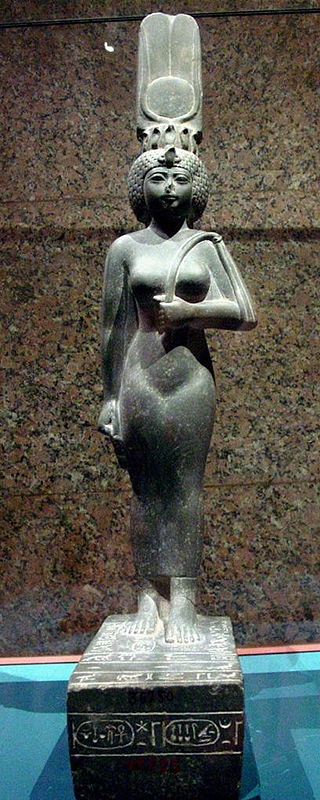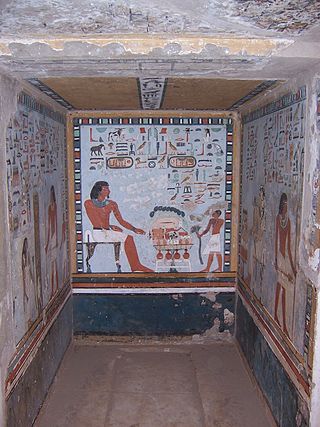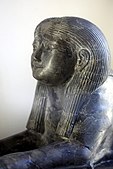Related Research Articles

Qakare Ibi was an ancient Egyptian pharaoh during the early First Intermediate Period and the 14th ruler of the Eighth Dynasty. As such Qakare Ibi's seat of power was Memphis and he probably did not hold power over all of Egypt. Qakare Ibi is one of the best attested pharaohs of the Eighth Dynasty due to the discovery of his small pyramid in South Saqqara.

Amenemhat III, also known as Amenemhet III, was a pharaoh of ancient Egypt and the sixth king of the Twelfth Dynasty of the Middle Kingdom. He was elevated to throne as co-regent by his father Senusret III, with whom he shared the throne as the active king for twenty years. During his reign, Egypt attained its cultural and economic zenith of the Middle Kingdom.

Sobekneferu or Neferusobek was a pharaoh of ancient Egypt and the last ruler of the Twelfth Dynasty of the Middle Kingdom. She ascended to the throne following the death of Amenemhat IV, possibly her brother or husband, though their relationship is unproven. Instead, she asserted legitimacy through her father Amenemhat III. Her reign lasted 3 years, 10 months, and 24 days, according to the Turin King List.

Amenemhat IV was the seventh and penultimate king of the late Twelfth Dynasty of Egypt during the late Middle Kingdom period. He arguably ruled around 1786–1777 BC for about nine regnal years.

Nubkaure Amenemhat II, also known as Amenemhet II, was the third pharaoh of the 12th Dynasty of ancient Egypt. Although he ruled for at least 35 years, his reign is rather obscure, as well as his family relationships.

Amenirdis I was a God's Wife of Amun during the 25th Dynasty of ancient Egypt. Originating from the Kingdom of Kush, she was the daughter of Pharaoh Kashta and Queen Pebatjma, and was later adopted by Shepenupet I. She went on to rule as high priestess, and has been shown in several artifacts from the period.

Hor Awibre was an Egyptian pharaoh of the early 13th Dynasty in the late Middle Kingdom.

Sekhemre-Heruhirmaat Intef was an ancient Egyptian king of the Seventeenth Dynasty of Egypt, who ruled during the Second Intermediate Period, when Egypt was divided between the Theban-based 17th Dynasty in Upper Egypt and the Hyksos 15th Dynasty who controlled Lower and part of Middle Egypt.

Ankhnesneferibre was an ancient Egyptian princess and priestess during the 26th Dynasty, daughter of pharaoh Psamtik II and his queen Takhuit. She held the positions of Divine Adoratrice of Amun and later God's Wife of Amun between 595 and 525 BC, during the reigns of Psamtik II, Apries, Amasis II and Psamtik III, until the Achaemenid conquest of Egypt.

Shepenupet II was an ancient Egyptian princess of the 25th Dynasty who served as the high priestess, the Divine Adoratrice of Amun, from around 700 BC to 650 BC. She was the daughter of the first Kushite pharaoh Piye and sister of Piye's successors, Shabaka and Taharqa.

Neferuptah or Ptahneferu was a daughter of the Egyptian king Amenemhat III of the 12th Dynasty. Her sister was the Pharaoh Sobekneferu.
Iufni was an ancient Egyptian pharaoh of the 13th Dynasty during the Second Intermediate Period.

The Department of Egyptian Antiquities of the Louvre is a department of the Louvre that is responsible for artifacts from the Nile civilizations which date from 4,000 BC to the 4th century. The collection, comprising over 50,000 pieces, is among the world's largest, overviews Egyptian life spanning Ancient Egypt, the Middle Kingdom, the New Kingdom, Coptic art, and the Roman, Ptolemaic, and Byzantine periods.

The Northern Mazghuna Pyramid is an ancient Egyptian royal tomb which was built during the 12th or 13th Dynasty in Mazghuna, 5 km south of Dahshur. The building remained unfinished, and it is still unknown which pharaoh was really intended to be buried here since no appropriate inscription has been found.

The Bust of Amenemhat V is a sculpture showing the head of the ancient Egyptian king Amenemhat V, who ruled at the beginning of the Thirteenth Dynasty. One of the major art works of this period, it is today in the Kunsthistorisches Museum in Vienna with the inventory number ÄS 37.

The Statue of Sobekneferu was a sculpture of the ancient Egyptian queen Sobekneferu, who reigned during the 12th Dynasty.

Sarenput II, also called Nubkaurenakht was an ancient Egyptian nomarch during the reign of pharaohs Senusret II and Senusret III of the 12th Dynasty.

Khenmet was an ancient Egyptian king's daughter of the Twelfth Dynasty, around 1800 BC. She is mainly known from her unrobbed tomb containing a set of outstanding personal adornments.
Sebat was an ancient Egyptian king's daughter of the Twelfth Dynasty. Her only known title is king's daughter of his body. She is so far only attested on the back slab of a statue base found at Serabit el-Khadim on Sinai. The statues are now lost but once depicted a falcon, king Amenemhat I and king Senusret I. The inscription mentions at the top Amenemhat II and in a lower register Senusret I, the king's daughter Sebat, the king's wife Neferu, Amenemhat I and again Senusret I. From this evidence it seems clear that Sebat was the daughter of Senusret I and Neferu and the sister of Amenemhat II.

Itaweret was an Ancient Egyptian king's daughter who lived in the 12th Dynasty around 1850 BC. She is known from her burial next to the pyramid of king Amenemhat II at Dahshur. The burial was found intact and contained a decorated wooden coffin and canopic box with longer religious texts including her name. Some personal adornments were found in the tomb too. The location of the tomb might indicate that she was a daughter of Amenemhat II, but a final proof is missing. Remarkable is the wooden statue of a swan found in her burial apartments.
References
- ↑ Biri Fay: The Louvre Sphinx and Royal Sculpture from the Reign of Amenemhat II, von Zabern, Mainz 1996, ISBN 3-8053-1760-3, pp. 30-32, 44-45
- ↑ Jacques de Morgan et al.: Fouilles a Dahchour 1894-1895. Volume II, Holzhausen, Vienna 1903, pp. 50–55
- ↑ Biri Fay: The Louvre Sphinx and Royal Sculpture from the Reign of Amenemhat II, von Zabern, Mainz 1996, ISBN 3-8053-1760-3, pp. 44
